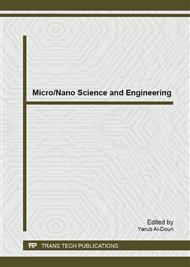p.374
p.379
p.385
p.390
p.396
p.401
p.406
p.411
p.416
Study on Synthesis and Characterization of Cu-Ni Doped TiO2 by Sol-Gel Hydrothermal
Abstract:
Titania (TiO2) as a semiconductor has been intensively studied during the last decades. Regardless of its superior photocatalytic performance and extensive environmental applications, it has a wide bandgap which lead to a photocatalytic activity only in ultraviolet (UV) irradiation. To shift the activity of TiO2 to visible region, a series of monometallic and bimetallic doped TiO2 was prepared with 10wt% total metals loading. The photocatalysts were synthesized by sol-gel associated via hydrothermal method. The properties of the photocatalysts such as crystal size, surface morphology, total surface area, chemical state of the elements, and bandgap were investigated by using thermogravimetric analysis (TGA), X-ray diffraction (XRD), field-emission scanning electron microscopy (FESEM), and Brunauer–Emmett–Teller (BET) measurement. XRD analysis showed that all samples displayed anatase (101) as a main phase of TiO2 with average crystal size between 10-16 nm in a good agreement with the TEM results. The FESEM images show spherical particles less than 20 nm in size. The BET results indicated that all samples are mesoporous. The band gap of Ni-Cu/TiO2 is reduced to 2.65 eV with more absorbance in the visible region compared to those of cu/TiO2 and Ni/TiO2.
Info:
Periodical:
Pages:
396-400
Citation:
Online since:
April 2014
Authors:
Keywords:
Price:
Сopyright:
© 2014 Trans Tech Publications Ltd. All Rights Reserved
Share:
Citation:


